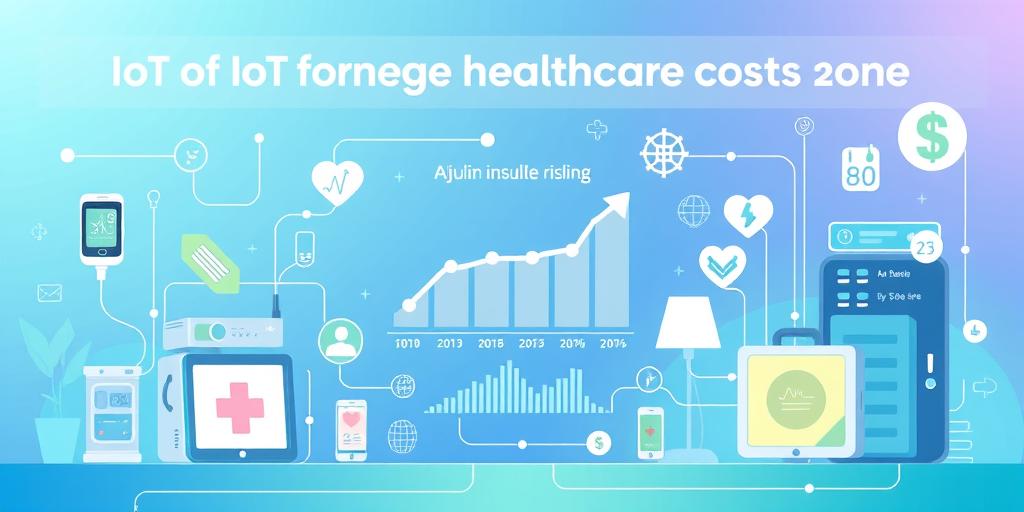Have you ever wondered how the Internet of Things (IoT) is secretly impacting your healthcare costs? It’s more intertwined than you might think! From the smartwatches tracking your heart rate to the insulin pumps managing your diabetes, IoT devices are revolutionizing healthcare – and influencing the price tag. Let’s dive into the fascinating, and sometimes surprising, ways IoT is affecting your healthcare spending.
The Rising Costs of Connected Healthcare
The integration of IoT devices in healthcare has undoubtedly improved patient care and medical efficiency. However, this advancement comes with a significant cost. The initial investment in purchasing and installing IoT devices can be substantial, especially for hospitals and large healthcare systems. This includes not only the devices themselves but also the infrastructure needed to support them, such as robust networks and data storage solutions. Think about it: hospitals need to upgrade their entire IT infrastructure to handle the massive amounts of data generated by these connected devices, and that’s expensive! This is often overlooked in the initial cost-benefit analyses. Moreover, maintaining these devices and ensuring their security is an ongoing expense, adding to the overall cost of healthcare. Consider the cost of replacing malfunctioning devices, the cost of software updates, and the ever-present need for cybersecurity measures to protect sensitive patient data. This hidden cost of security is increasingly influencing the financial decisions of healthcare providers.
Unexpected Expenses
Beyond the initial purchase and maintenance, there are additional, often unforeseen, costs associated with IoT implementation in healthcare. For example, there’s the cost of training staff to use these new technologies effectively. This is a significant investment in human resources, and can involve dedicated training sessions, onboarding programs, and ongoing support. Further, integrating IoT devices into existing healthcare systems can be complex, often requiring specialized expertise and leading to further expenditure on consultants and integration specialists. It’s not as simple as just plugging in a device; it’s a whole system integration challenge.
IoT’s Impact on Remote Patient Monitoring
Remote patient monitoring (RPM) is one area where IoT is making a significant impact. Wearable sensors, connected medical devices, and telehealth platforms allow healthcare providers to track patient health data in real-time from a distance. While this can improve patient outcomes by enabling early intervention and reducing hospital readmissions, it also adds to healthcare costs. RPM programs often require specialized software and personnel to manage the data streams and coordinate care. The cost of this software, combined with the expense of employing skilled personnel capable of analyzing patient data remotely, contributes to higher healthcare costs. However, the long-term cost savings from reduced hospital stays and improved patient outcomes may outweigh these initial investments, presenting a nuanced picture of the financial impact. Long-tail keywords like “cost of remote patient monitoring” and “IoT impact on remote patient care costs” become highly relevant in this context.
Balancing Cost and Efficiency in RPM
Effectively managing the costs associated with RPM requires careful planning and strategic implementation. Healthcare providers need to choose the right technologies, ensuring they are cost-effective and compatible with their existing infrastructure. Streamlining workflows and optimizing data management processes is key to containing costs. Investing in robust training for staff using RPM technologies is essential to maximize the effectiveness and minimize errors. Ultimately, balancing cost and efficiency in RPM involves a thorough cost-benefit analysis that considers both the upfront investment and the long-term potential savings.
The Potential for Cost Savings with IoT
Despite the added costs, IoT offers significant potential for long-term savings in healthcare. By improving efficiency, reducing hospital readmissions, and enabling early interventions, IoT can ultimately lower overall healthcare expenditures. For example, early detection of chronic disease progression using connected devices can lead to more timely and effective treatment, reducing the need for costly hospitalizations later on. Similarly, remote patient monitoring can allow for quicker responses to health crises, minimizing the severity of conditions and reducing the need for expensive emergency room visits. The trick is to carefully weigh the initial investment with the predicted long-term cost savings.
Predictive Analytics and Cost Reduction
The data collected by IoT devices allows healthcare providers to leverage predictive analytics. By analyzing patient data, providers can identify individuals at high risk of developing certain conditions. This proactive approach allows for timely interventions, preventing the onset or progression of diseases. Preventing costly hospitalizations through early interventions and proactive care is a major benefit of IoT-enabled healthcare, although its potential savings may not be immediately apparent. This preventative aspect shifts focus from reactive cost management to proactive cost reduction. Keywords such as “IoT predictive analytics in healthcare cost reduction” and “preventative healthcare cost savings” are extremely relevant here.
The Future of IoT in Healthcare Costs
The future impact of IoT on healthcare costs remains to be seen. As technology advances and the cost of IoT devices decreases, we can expect the cost of implementation to become more manageable. Improvements in data analytics and the development of more sophisticated algorithms will further optimize cost efficiency. However, the ongoing need for cybersecurity measures and skilled personnel to manage and interpret the data will continue to influence overall costs. Understanding this complex interplay of costs and benefits is crucial for navigating the future of healthcare financing. Keywords such as “future trends in IoT healthcare costs” and “cost-effectiveness of IoT in healthcare” encapsulate these crucial future considerations.
Take control of your healthcare costs today! Explore the potential benefits and challenges of IoT in healthcare and make informed decisions to manage your health and your finances effectively. Find out how IoT can impact your future healthcare spending – start exploring today!




